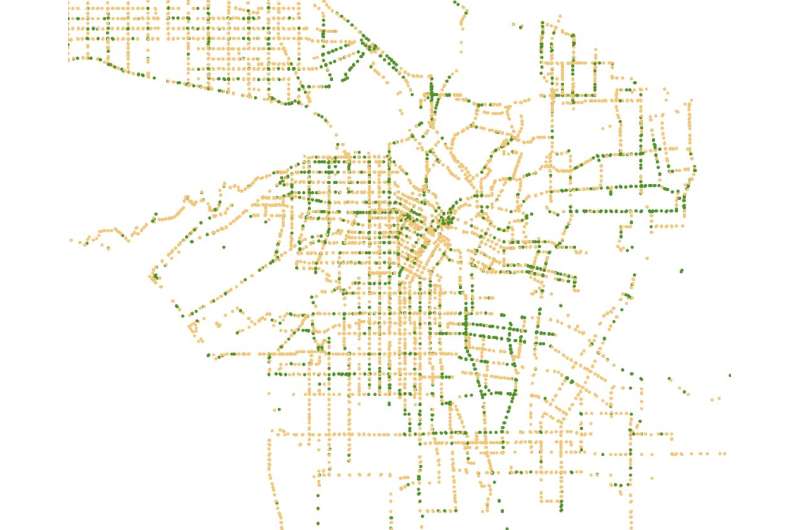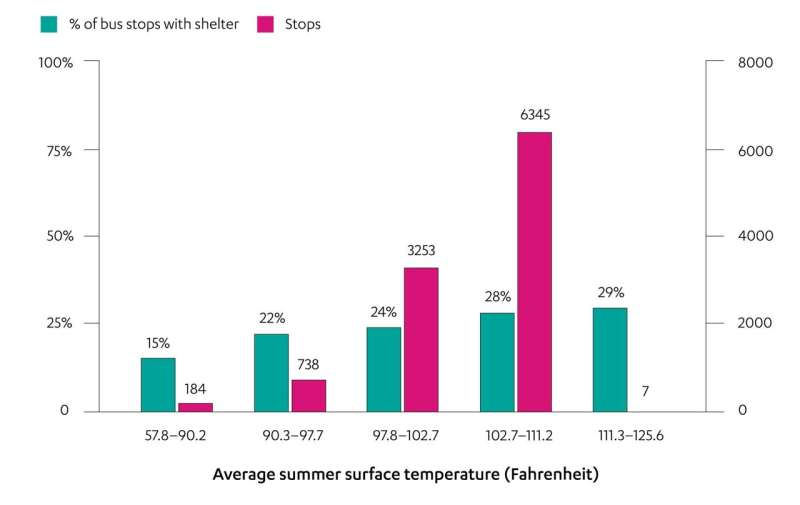Study finds only a quarter of LA Metro bus stops offer shade
According to a new UCLA report, only 26% of Los Angeles Metro bus stops have shelters that provide shade.
The figure is significant because some of the Los Angeles residents who are most likely to get around the city on foot or using public transportation will be among the populations who, in the coming years, will have the highest risks for death from heat-related causes. And research has demonstrated that bus shelters are a proven way to help mitigate the impact of extreme heat.
In the U.S. overall, extreme heat already kills more people than any other natural disaster.
And a 2020 study by the Los Angeles Urban Cooling Collaborative found that as Los Angeles gets hotter, Black, Latino and older adults will experience the largest increases in mortality due to increases in extreme heat.
So researchers at the UCLA Lewis Center for Regional Policy Studies, in collaboration with the advocacy group MoveLA, wanted to create a baseline understanding of how prevalent shelters are for Los Angeles bus riders, especially with legislation on the topic now being considered in the California State Assembly. More than 60 transit agencies provide service to the region, but Metro is the largest and was the focus of the new study. Researchers analyzed where in Los Angeles shelters are located, measured their locations against average summer temperatures, and compared the numbers of shelters across cities and legislative districts.
A look at some of the key findings:
Metro bus stops
Metro is the largest transit agency in Los Angeles County, and its bus system is the second largest in the nation, providing bus service for more than 560,000 daily riders. There are a total of 12,228 Metro bus stops, and of the 10,526 stops with available data, only 26% currently have shelters to provide shade for customers waiting for a bus. On this map, green dots indicate bus stops with shelters; all other stops are represented by yellow dots.

Prevalence of bus stops and shelters by heat bands
Across the region, the likelihood of having a bus shelter is low, regardless of whether transit customers are in cool, coastal climates or the San Fernando Valley. The majority of bus stops, however, are located in the county’s hotter areas, where average high temperatures during the summer months reach 97 degrees.
Bus shelter distribution by city in Los Angeles County
California cities and counties are largely responsible for building and maintaining their bus shelters. This patchwork of governance leads to a distribution of bus shelters that varies greatly by city. In the city of Bell, 89% of bus stops have shelters; Beverly Hills, Downey and Bellflower all have less than 10% of their bus stops covered.
More information:
Are LA bus riders protected from extreme heat? Analyzing bus shelter provision in Los Angeles County: www.lewis.ucla.edu/publication … r-from-the-elements/
Citation:
Study finds only a quarter of LA Metro bus stops offer shade (2023, February 17)
retrieved 17 February 2023
from https://phys.org/news/2023-02-quarter-la-metro-bus.html
This document is subject to copyright. Apart from any fair dealing for the purpose of private study or research, no
part may be reproduced without the written permission. The content is provided for information purposes only.

According to a new UCLA report, only 26% of Los Angeles Metro bus stops have shelters that provide shade.
The figure is significant because some of the Los Angeles residents who are most likely to get around the city on foot or using public transportation will be among the populations who, in the coming years, will have the highest risks for death from heat-related causes. And research has demonstrated that bus shelters are a proven way to help mitigate the impact of extreme heat.
In the U.S. overall, extreme heat already kills more people than any other natural disaster.
And a 2020 study by the Los Angeles Urban Cooling Collaborative found that as Los Angeles gets hotter, Black, Latino and older adults will experience the largest increases in mortality due to increases in extreme heat.
So researchers at the UCLA Lewis Center for Regional Policy Studies, in collaboration with the advocacy group MoveLA, wanted to create a baseline understanding of how prevalent shelters are for Los Angeles bus riders, especially with legislation on the topic now being considered in the California State Assembly. More than 60 transit agencies provide service to the region, but Metro is the largest and was the focus of the new study. Researchers analyzed where in Los Angeles shelters are located, measured their locations against average summer temperatures, and compared the numbers of shelters across cities and legislative districts.
A look at some of the key findings:
Metro bus stops
Metro is the largest transit agency in Los Angeles County, and its bus system is the second largest in the nation, providing bus service for more than 560,000 daily riders. There are a total of 12,228 Metro bus stops, and of the 10,526 stops with available data, only 26% currently have shelters to provide shade for customers waiting for a bus. On this map, green dots indicate bus stops with shelters; all other stops are represented by yellow dots.

Prevalence of bus stops and shelters by heat bands
Across the region, the likelihood of having a bus shelter is low, regardless of whether transit customers are in cool, coastal climates or the San Fernando Valley. The majority of bus stops, however, are located in the county’s hotter areas, where average high temperatures during the summer months reach 97 degrees.
Bus shelter distribution by city in Los Angeles County
California cities and counties are largely responsible for building and maintaining their bus shelters. This patchwork of governance leads to a distribution of bus shelters that varies greatly by city. In the city of Bell, 89% of bus stops have shelters; Beverly Hills, Downey and Bellflower all have less than 10% of their bus stops covered.
More information:
Are LA bus riders protected from extreme heat? Analyzing bus shelter provision in Los Angeles County: www.lewis.ucla.edu/publication … r-from-the-elements/
Citation:
Study finds only a quarter of LA Metro bus stops offer shade (2023, February 17)
retrieved 17 February 2023
from https://phys.org/news/2023-02-quarter-la-metro-bus.html
This document is subject to copyright. Apart from any fair dealing for the purpose of private study or research, no
part may be reproduced without the written permission. The content is provided for information purposes only.
